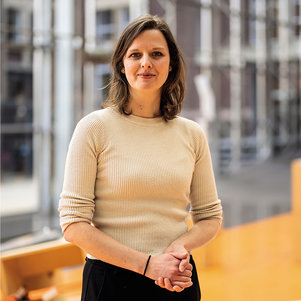How do you build for a more inclusive, social and equitable city? Céline Janssen investigated the success factors for achieving social sustainability goals with urban development projects. “Social sustainability is about more than investing in amenities alone: it’s about residents actually using them.”
You might say that social cities are a multi-faceted topic. You might also say: what is a social city in the first place? Céline Janssen delved into the issue for her dissertation on ‘Developing places for human capabilities: Understanding how social sustainability goals are governed into urban development projects’. “Social sustainability is about improving people’s quality of life in cities, for current and future generations,” Janssen explains. “Academic and political interest in social objectives is increasing, with more people realising the importance of developing an equitable, inclusive living environment for all. A laudable aim, but it begs the question: can it actually be done? And if so, how?”
Janssen is primarily interested in what factors spark successful social urban developments: “The planning side of things has been thoroughly researched, but studies on implementation and governance are few and far between. You can come up with countless ideas to improve quality of life in theory, but practice is often a different story altogether. And even in the best of neighbourhoods, people living in sub-par housing experience little social sustainability. Similarly, if you have a stellar public transport network that goes unused because people can’t afford it, you’ve hardly built an inclusive amenity.”
Social sustainability is about whether amenities, once they’ve been built, ultimately help people.
Céline Janssen
Capability approach
Janssen decided to take a capability approach to the issue: “It’s a framework that establishes whether individuals have the freedom to do the things they care about, such as educating oneself, travelling across the city or taking part in social networks. To perform these capabilities, a city needs amenities such as good housing, public transport and parks. While urban development projects revolve entirely around delivering such physical outcomes, the amenity or resource in question will only serve as a means to an end in people’s lives. Social sustainability is about whether physical resources, once they’ve been built, ultimately help people.”
Janssen examined four different urban development projects for her dissertation, identifying the resulting capabilities in each of the four cases. In the process, she interviewed residents on ‘urban functionings’ such as residing comfortably, interacting with neighbours, doing sports or exercise in the area or taking part in neighbourhood initiatives. Janssen: “Whether or not physical resources in cities are used by people is a product of many different context-dependent factors. One of the residential blocks I studied had a shared living room that was supposed to serve an important social function. I discovered that there were certain factors that determined whether spaces like these are actually used, like whether it was on your way home from work. Another factor was coaches who helped organise initiatives to give meaning and purpose to those spaces, such as language classes. There can be a thin line between unmitigated success and abject failure.”
Good governance
To achieve good outcomes – or capabilities – you need a plan, collaborations among actors and well-functioning institutions. Janssen also investigated the governance side of things, comparing two urban development projects in Amsterdam and Rotterdam. “I discovered roughly three key factors in the development process that ensure that social plans actually come to fruition. First, you need clearly crystallised social sustainability goals that focus on capabilities. Moreover, close cooperation between developers and users and strong agreements on how project interventions will be evaluated and managed are required. Finally, it is important that the end goal of the project, e.g. improving quality of life, should be upheld even after delivery: a project should not be considered ‘done’ once all the buildings have been delivered.”
Socially sustainable developments therefore require more than just a well-laid plan. Janssen’s research also saw her go abroad, finding that social sustainability principles were more firmly embedded in governance in other countries: “I found that capability-oriented governance was more deeply ingrained in the culture, for example, or even in legislation. When capabilities are part and parcel of the planning culture, everyone working on a project will keep one eye on the objectives at all times, increasing the odds of success.”
After all, the end goal is what matters in urban development: giving residents a nicer, more equitable place to live.
Céline Janssen
A nicer place to live
While it may sound obvious that policymakers and developers should not forget to manage the outcomes of their social plans, Janssen has found that doing so can be complicated: “One of my conclusions has been that you can never guarantee social sustainability with urban development projects only, as places will always mean different things to different people! Fortunately, there are a few clearly identifiable elements that help to get closer to the ultimate goal.” For now, Janssen warns that physical resources are often prioritised over human capabilities: “but I hope that the focus will gradually shift. After all, the end goal is what matters in urban development: giving residents a nicer, more equitable place to live.”
Published: January 2024
More information
On 15 January 2024, Céline Janssen defended her thesis ‘Developing places for human capabilities: Understanding how social sustainability goals are governed into urban development projects’.

